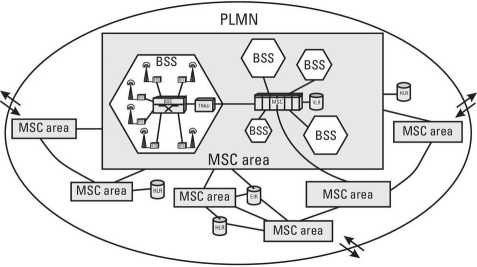6781097068
Introduction 5

Figurę 1.2 The architecture of a PLMN.
1.2.2.1 Mobile Station
GSM-PLMN contains as many MSs as possible, available in various styles and power classes. In particular, the handheld and portable sta-tions need to be distinguished.
1.2.2.2 Subscriber Identity Module

GSM distinguishes between the identity of the subscriber and that of the mobile equipment. The SIM determines the directory number and the calls billed to a subscriber. The SIM is a database on the user side. Physically, it consists of a chip, which the user must insert into the GSM telephone before it can be used. To make its handling easier, the SIM has the format of a credit card or is inserted as a plug-in SIM. The SIM communicates directly with the VLR and indirectly with the HLR.
1.2.2.3 Base Transceiver Station

A large number of BTSs take care of the radio-related tasks and provide the connectivity between the network and the mobile station via the Air-interface.
1.2.2.4 Base Station Controller

The BTSs of an area (e.g., the size of a medium-size town) are con-nected to the BSC via an interface called the Abis-interface. The
Wyszukiwarka
Podobne podstrony:
Figurę 4: Basic architecture of a UMTS mobile network (Release 99) (from [11]). be reached. Figurę 5
IMGx49 79 The Origin of ChUisation Figurę S.4 The Ęyohition of Culture 3 u The Total Culture System
Michał PTAK Figurę 2. The structure of the support for renewable energy sources provided by regional
18 Małgorzata Bednarczyk, Ewa Wszendybył-Skulska According to the model presented in Figurę 2, the e
SPE 84856 Figurę 3: The mast of the pulsing tool with the hydraulic unit in the background. LENGEND
Tracking errors decreasing in CNC system of machinę tools 89 Fig. 3. The architecture of CNC control
SCAN0088 (3) 284 Introduction to the Pronunciation of English11.02 Neutralization of Weak Forms We h
SCAN0086 (2) 260 Introduction to the Pronunciation of English seems m it seems impossible wants, hav
SCAN0087 (2) 262 Introduction to the Pronunciation of English Unaccented Accented are /a/ +
SCAN0088 (3) 284 Introduction to the Pronunciation of English11.02 Neutralization of Weak Forms We h
SCAN0089 (3) 286 Introduction to the Pronunciation of English11.04 Phonetic Variat
SCAN0091 (3) 292 Introduction to the Pronunciation of English 11.09 Phonemic assimilations involving
SCAN0089 (3) 286 Introduction to the Pronunciation of English11.04 Phonetic Variations at Word or Mo
więcej podobnych podstron